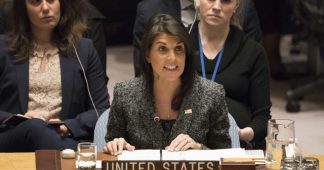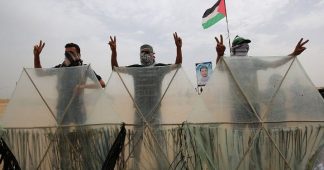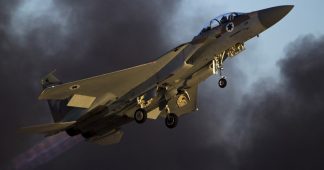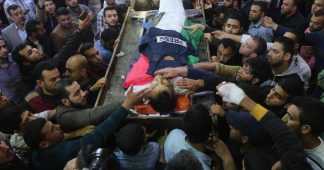By Robert Mackey
A confidential report by Israeli military police investigators seen by The Intercept explains how a tragic series of mistakes by air force, naval, and intelligence officers led to an airstrike in which four Palestinian boys playing on a beach in Gaza in 2014 were killed by missiles launched from an armed drone.
Testimony from the officers involved in the attack, which has been concealed from the public until now, confirms for the first time that the children — four cousins ages 10 and 11 — were pursued and killed by drone operators who somehow mistook them, in broad daylight, for Hamas militants.
The testimony raises new questions about whether the attack, which unfolded in front of dozens of journalists and triggered global outrage, was carried out with reckless disregard for civilian life and without proper authorization. After killing the first boy, the drone operators told investigators, they had sought clarification from their superiors as to how far along the beach, used by civilians, they could pursue the fleeing survivors. Less than a minute later, as the boys ran for their lives, the drone operators decided to launch a second missile, killing three more children, despite never getting an answer to their question.
Suhad Bishara, a lawyer representing the families of the victims, told The Intercept that Israel’s use of armed drones to kill Palestinians poses “many questions concerning human judgment, ethics, and compliance with international humanitarian law.”
Remotely piloted bombers “alter the process of human decision-making,” Bishara said, and the use of the technology in the 2014 beach attack “expands the circle of people responsible for the actual killing of the Bakr children.”
Just hours before the attack, on the morning of July 16, 2014, the public relations unit of the Israel Defense Forces had been promoting the idea that the live video feeds provided by drones enabled its air force to avoid killing Palestinian civilians.
The PR unit released operational footage, apparently taken from the screens of Israeli drone operators, which documented how three Israeli airstrikes had been called off that week because figures, identified as civilians, had appeared close to targets in the densely populated Gaza Strip.
Those images were released one week into Israel’s Operation Protective Edge, a 50-day offensive against Hamas militants in Gaza in which Israel would eventually kill 1,391 civilians, including 526 children.
Later that same day, at about 3:30 p.m., an Israeli Hermes 450 surveillance drone hovering over a beach in Gaza City transmitted images of eight figures clambering from the strand onto a jetty.
A small shipping container on the jetty had been destroyed by an Israeli missile the day before, based on intelligence indicating that it might have been used by Hamas naval commandos to store weapons. Some analysts have questioned that intelligence, however, since there were no secondary explosions after the structure was hit and journalists staying in nearby hotels reported that no militants had been seen around the jetty that week.
The Israeli military police report reviewed by The Intercept documents what happened next. After one of the figures on the jetty entered the container that had been destroyed the previous day, an Israeli air force commander at the Palmachim air base, south of Tel Aviv, ordered the operators of a second drone, which was armed, to fire a missile at the container.
As my colleagues Cora Currier and Henrik Moltke reported in 2016, although the Israeli government maintains an official stance of secrecy around its use of drones to carry out airstrikes, hacked Israeli surveillance images provided to The Intercept by former National Security Agency contractor Edward Snowden showed an Israeli drone armed with missiles in 2010.
Speaking privately to a visiting American diplomat after Israel’s 2009 offensive in Gaza, Avichai Mandelblit, who was the country’s chief military prosecutor at the time and now serves as its attorney general, acknowledged that two missiles that injured civilians in a mosque had been fired from an unmanned aerial vehicle, according to a leaked State Department cable.
One reason that Israel might decline to acknowledge that its drones have been used to kill Palestinian children is that such information could complicate sales of its drones to foreign governments. In June, the state-owned company Israel Aerospace Industries signed a $600 million deal to lease Heron drones to Germany’s defense ministry. That deal was initially delayed by concerns from German politicians that the drones, to be used for surveillance, could also be armed. The same state-owned company has also sold drones to Turkey, a strongly pro-Palestinian nation, which has nonetheless used the Israeli technology to bomb Kurds in Iraq.
The Israeli military police report on the 2014 strike seen by The Intercept offers the most direct evidence to date that Israel has used armed drones to launch attacks in Gaza. Testimony from the drone operators, commanders, and intelligence officers who took part in the attack confirms that they used an armed drone to fire the missile that slammed into the jetty, killing the person who had entered the container, and also to launch a second strike, which killed three of the survivors as they fled across the beach.
According to the testimony of one naval officer involved in the strikes, the mission was initially considered “a great success,” because the strike team believed, wrongly, that they had killed four Hamas militants preparing to launch an attack on Israeli forces.
Within minutes of the two strikes, however, a group of international journalists who had witnessed the attack from nearby hotels reported that the victims torn apart by the missiles were not adult militants but four small boys, cousins who were 10 and 11 years old. Another four boys from the same family survived the attack, but were left with shrapnel wounds and deep emotional scars.
Harrowing images of the children running desperately across the beach after the first missile had killed their cousin were quickly shared by a Palestinian photographer, an Al Jazeera reporter and a camera crew from French television.
A brutal image of the immediate aftermath captured by Tyler Hicks of the New York Times, one of the journalists who witnessed the attack, made the killing of the four boys, all of them sons of Gaza fishermen from the Bakr family, reverberate worldwide.
Maybe it’s the fact that I walked on that beach—and have a small child that makes this photo so devastating. #Gaza pic.twitter.com/s067RShbVh
— Anthony Bourdain (@Bourdain) July 16, 2014
The French TV correspondent Liseron Boudoul, whose report that day included distressing video of the boys running along the beach before the second strike, noted that she and other witnesses to the attack were unclear where, exactly, the missiles had come from — although initial speculation centered on Israeli naval vessels seen just offshore.
The secret testimony from the Israeli military personnel involved in the attack establishes for the first time that the drone operators treated the jetty as a free-fire zone on the mistaken assumption that it was off-limits to anyone but militants.
After images of the attack prompted widespread outrage, Israel’s army conducted a review of the mission and recommended that a military police investigation into possible criminal negligence be conducted. The testimonies collected by the military police from the strike team were included in a report presented to Israel’s military advocate general, Maj. Gen. Danny Efroni, 11 months after the boys were killed.
Efroni did not release the testimonies, but did make a summary of the report’s findings public on June 11, 2015, when he closed the investigation without filing any charges. Israel’s chief military prosecutor decided that no further criminal or disciplinary measures would be taken, since the investigators had concluded that “it would not have been possible for the operational entities involved to have identified these figures, via aerial surveillance, as children.”
Efroni did not explain why that was impossible. Two days before the strike in question, Israel’s military PR unit had released another video clip in which drone operators could be heard deciding to halt strikes because they had identified figures in their live feeds as children.
Adalah, also known as the Haifa-based Legal Center for Arab Minority Rights in Israel, has spent the past three years fighting on behalf of the families of the boys — Ismail Bakr, 10; Ahed Bakr, 10; Zakaria Bakr, 10; and Mohammed Bakr, 11 — to have the decision not to prosecute the soldiers overturned by an Israeli court.
Much of that time has been spent waiting for Israel’s attorney general, Mandelblit, to simply reply to appeals filed by Adalah and two Gazan rights groups, the Palestinian Center for Human Rights and Al Mezan Center for Human Rights.
In February, Adalah said in a statement that Israel’s own investigation “revealed that the Israeli military did not take any measures to ascertain whether the targets on the ground were civilians, let alone children, prior to intentionally directing the attacks against them.”
Bishara, one of the Adalah lawyers representing the boys’ families, told The Intercept in a telephone interview that the Israeli investigation of the killings, in which the military cleared itself of wrongdoing, was flawed in several ways. To start with, the testimonies were only collected by the military police four months after the incident, and only considered what could be seen of the beach through the drone cameras. No testimony was taken from the international journalists who witnessed the attack, and the accounts of Palestinian witnesses, including written affidavits from boys injured in the strikes, were discounted.
A Wall Street Journal video report filed on the day of the attack by Nick Casey, a correspondent staying in a hotel close to the jetty, cast doubt on the Israeli intelligence that designated the site a Hamas compound. Casey’s report, which featured images of the first young victim’s mangled body being taken from the jetty, explained that “no one knew why this place had been bombarded; there have been no Hamas attacks from here and no rockets that we’ve seen.”
When the Israeli authorities closed the case in 2015, Alexander Marquardt, a former ABC Jerusalem correspondent who had also witnessed the attack, disputed the finding that the jetty was sealed off from the beach, arguing that it was open to civilians.
According to the testimony seen by The Intercept, one of the officers involved in the missile strikes told investigators that when he saw one of the figures entering the destroyed container, he had checked with an intelligence officer to be sure that only militants could enter the compound before opening fire.
However, the chief intelligence naval officer, a woman identified only as “Colonel N.” in the report, testified that since the entrance to the area was unguarded on the day of the attack, it was not closed to civilians.
Although the copy of the report reviewed by The Intercept includes redactions, there is no indication as to why this apparent discrepancy between the two testimonies was ignored when the decision to close the investigation was made.
One of the officers also testified that although the site was surrounded by a fence when the intelligence estimate was made before Operation Protective Edge began, the fence could have been destroyed in the previous day’s attack, leaving the jetty open to the public.
One soldier told investigators that according to “dozens” of statements from Gaza fishermen, the local population was aware that the jetty was a Hamas compound. The source of this claim is unknown, however, and a lawyer who has worked on the Adalah appeal told The Intercept that there was no evidence to support it in the parts of the report the army was obliged to share with the victims’ families.
Everyone involved in the strike, including the air force officer who coordinated the attack from Palmachim air base, told investigators that even though they had a live video feed of the area during the attack, “we couldn’t tell they were children.”
The testimonies also reveal a crucial moment when the attack could have been halted, but was not. After the first missile was fired at the shack, killing one of the boys, and the other children ran out to the beach, the attack team requested clarification about how far onto the beach they were permitted to fire.
The attack team radioed a superior officer, asking where, exactly, the area designated a closed military zone ended. They wanted to know if there was a point at which they could no longer shoot at the fleeing figures, as they approached an area of beach umbrellas and tents used by civilians.
When they received no response to that query, the attack team fired a second missile at the fleeing children, about 30 seconds after the first strike, which killed three of the boys and wounded at least one more of their cousins.
One naval officer, who took part in the life-and-death decisions, testified that to the best of his recollection, they had launched the second missile while the fleeing figures were still inside what they took to be a closed military compound, but the missile had landed after the fleeing figures were already outside it, on the beach.
The air force officer who coordinated the strikes told investigators that he had previously been in charge of “hundreds of attacks,” but this incident remained “engraved” in his memory because the intelligence that the strike team was given was a 180-degree difference from the facts on the ground.
Adalah, which filed an updated appeal in the case in May and is still waiting for a response, also noted that the Israeli authorities have refused to let lawyers for the families see any of the video from the two drones recorded during the attack.
Without seeing that video, it is impossible to say whether or not the drone operators should have been able to tell that their targets were children, but Eyal Weizman, an Israeli architect who has investigated drone strikes, has argued in the past that the optical resolution of drone cameras might not be nearly as high as military commanders claim.
After previously analyzing drone surveillance video of suspected Islamic State militants in Iraq, Weizman said it was only possible to tell that the figures were carrying weapons, and that one of them was a child, by studying their shadows. That identification was only possible, he said, because the video was “taken either very early or very late in the day.”
Since there would be no long shadow in aerial images recorded earlier in the afternoon — like those of the boys playing on the beach in Gaza that July day at around 3:30 p.m. — Weizman observed that high-resolution images selectively released by military commanders to justify airstrikes “could skew our understanding of how much can be seen by drones and how clear what we see is.” Most of the footage “that is continuously harvested by drones,” Weizman said, is “far more ambiguous.”
Asked this week about Israel’s policy of refusing to acknowledge the use of drones in lethal strikes, Weizman suggested that one reason might be connected to international law. “An important aspect of Israel’s deniability of drones is to do, I believe, with an unresolved legal problem,” Weizman wrote in an email. “The combination of distributed action — several participants remotely involved in the action — and the gravity of the act of targeted assassination.”
Hagai El-Ad, the director of the Israeli human rights group B’Tselem, told The Intercept that Israel’s use of armed drones was something of an open secret, but since the technology did not yet cut humans out of the decision-making process, the military commanders who ordered the strikes, and the drone pilots who executed them, were no less responsible for killing the boys than if they had been flying over the beach in a jet or a helicopter at the time.
El-Ad also pointed to a 2016 report his group produced on the failure of Israel’s military to conduct thorough investigations of the killing of civilians in Gaza: “Whitewash Protocol: The So-Called Investigation of Operation Protective Edge.”
“The various specific delays, gaps, failures in the so-called investigation are all part of that broad systematic way to eventually close the files, while producing all this paper trail which may look from the outside as a sincere effort,” El-Ad said. “It’s all totally routine.”
A spokesperson for Israel’s military did not respond to repeated requests to comment on the secret report before publication. After The Intercept published this information, a spokeswoman sent a statement which ignored a direct question about the use of an armed drone in the attack and reiterated the military’s position that the botched attack “was examined thoroughly and comprehensively” and no wrongdoing was discovered. The statement noted that the Israelis “targeted figures who were believed to be Hamas operatives,” and presented the disputed intelligence that the children had entered “a military compound belonging to the terrorist organization’s naval force,” as fact.
“The investigation further revealed that the strike was carried out according to standard procedures, as the forces took various precautionary measures to prevent harm to civilians, however there was an error in identifying the persons in the compound,” the army statement said. “The error was deemed reasonable considering the circumstances of the operation, the chaos and the dangers involved in ongoing war. Accordingly, in 2015, the investigation was terminated and the case was closed without any further legal action taken.”
Updated: Sunday, August 12, 1:52 p.m.
This article was updated to report a statement issued by Israel’s military after publication, and to add a quote from Eyal Weizman of Forensic Architecture and reference to a 2016 human rights report that criticized the Israeli military’s internal investigations of possible war crimes committed by its soldiers in Gaza in 2014.
Top Photo: Smoke billowed from a beachside shack in Gaza City on July 16, 2014, after two missiles fired by Israeli drone operators killed four young boys mistaken for militants.
Published at https://theintercept.com/2018/08/11/israel-palestine-drone-strike-operation-protective-edge/











